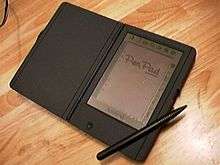PenPad
The term PenPad was used as a product name for a number of Pen computing products by different companies in the 1980s and 1990s. The earliest was the Penpad series of products by Pencept, such as the PenPad M200 handwriting terminal, and the PenPad M320 handwriting/gesture recognition tablet for MS-DOS and other personal computers.
Other vendors using the term Penpad in product names include Amstrad and Toshiba.
The Amstrad PenPad was an early portable personal digital assistant with handwriting pen input, and a competitor to the Apple Newton. It was an attempt by Amstrad, a UK electronics firm with a history of successful involvement in personal computing, to corner the handheld market in the UK and Europe.
PDA600

The Amstrad PenPad, also known by the PDA600 model reference, was commissioned in 1993 and launched in March of that year.[1] The project manager, Cliff Lawson, had helped developed Amstrad's previous computing products. The Eden Group delivered the underlying operating system, and the hardware was designed by Mutech Ltd. For its time the PenPad had a relatively successful handwriting recognition system, where the user would 'train' the PenPad with his own handwriting.
The User Interface contains, early in the history of computer technology, an example of skeuomorphism - the silk-screened border and the applications show the six-ring binder system familiar to Filofax users. When tapped, the rings cause the current page to be 'unclipped' from the application, and drawn at a smaller scale on the display. From here, the page can be dragged off the display to be deleted, or the rings can be tapped again to clip the page back into the application.
The device was bulky when compared with modern PDAs, but it was very functional with the standard PIM and offered expansion. It featured a calendar, address book, todo list, jot pad, world time, multiple alarms, calculator, and unit conversion on the ROM.
It has a low power version of the Zilog Z180 CPU clocked at 14 MHz, memory capacity of 128 KB, a monochrome LCD touchscreen, a folding hinged cover that protected the screen when not in use, a PCMCIA type I slot for expansion to 2 megabytes with SRAM cards, as well as a serial port to link to a PC.
Eden Group also wrote bespoke software for the PDA600 that run on PCMCIA memory cards, in addition to the standard PIM applications. The PDA600 could be synchronized and backed-up via Windows with the optional extra "PC-Organiser for Windows".
Over time, the rubber coating on the outside of the PenPad turns into a sticky substance which requires the user to scrape off the coating as heavy washing of skin that comes into contact with the PDA600 would be required if the user attempts to use it with the coating still on the system.
Development
Development of end-user applications was possible but required investment in a card-writer in addition to the forms software from Eden Group, which restricted end-user development.
Being discontinued
The Amstrad PenPad, like the Apple Newton, struggled in a time where these early PDAs were expensive to produce and did not manage to capture enough interest and eventually production was discontinued. The remaining UK units being sold off to Tandy Corporation who retailed the stock through their chain of stores at £50 per unit, half the price they had cost Amstrad to build. It wasn't until the launch of the Palm Pilot 1000 in 1996 that the first truly successful PDA relying on pen input was born.
Amstrad did invest in R&D for a successor to the PDA600, called the PIC700, but with the end of the PenPad it was never released.
See also
References
- Greenberg, Jeff. "PC Mag, October 12, 1993, page 143, "Amstrad PenPad 600"". books.google.com. Ziff Davis. Retrieved July 16, 2019.
External links
- The Unknown History of Pen Computing contains a history of pen computing from approximately 1917 to 1992.
- Annotated bibliography of references to handwriting recognition and pen computing
- PDA600 FAQ
- Amstrad PDA600
- Video Review of the PDA600 twenty-seven minutes
- Notes on the History of Pen-based Computing (YouTube)